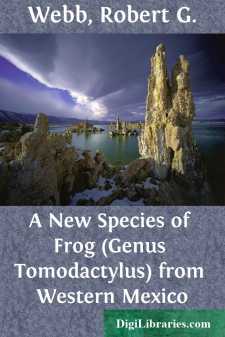Categories
- Antiques & Collectibles 13
- Architecture 36
- Art 48
- Bibles 22
- Biography & Autobiography 813
- Body, Mind & Spirit 142
- Business & Economics 28
- Children's Books 15
- Children's Fiction 12
- Computers 4
- Cooking 94
- Crafts & Hobbies 4
- Drama 346
- Education 46
- Family & Relationships 57
- Fiction 11828
- Games 19
- Gardening 17
- Health & Fitness 34
- History 1377
- House & Home 1
- Humor 147
- Juvenile Fiction 1873
- Juvenile Nonfiction 202
- Language Arts & Disciplines 88
- Law 16
- Literary Collections 686
- Literary Criticism 179
- Mathematics 13
- Medical 41
- Music 40
- Nature 179
- Non-Classifiable 1768
- Performing Arts 7
- Periodicals 1453
- Philosophy 64
- Photography 2
- Poetry 896
- Political Science 203
- Psychology 42
- Reference 154
- Religion 513
- Science 126
- Self-Help 84
- Social Science 81
- Sports & Recreation 34
- Study Aids 3
- Technology & Engineering 59
- Transportation 23
- Travel 463
- True Crime 29
A New Species of Frog (Genus Tomodactylus) from Western Mexico
by: Robert G. Webb
Description:
Excerpt
Thirteen specimens of frogs collected in the summers of 1960 and 1961 in the Mexican states of Durango and Sinaloa represent a heretofore unnamed species. The specimens have been deposited in the Museum of Natural History of the University of Kansas (KU) and in the Museum of Michigan State University (MSU). The species may be named and described as follows:
Tomodactylus saxatilis new species
Holotype.—KU 63326 (Fig. 1); obtained eight miles west of El Palmito, Sinaloa, approximately 6100 feet, on 23 June 1961; original field number, 2354 of Robert G. Webb.
Paratypes.—A total of 12 specimens: KU 63327-33, same data as holotype, 23-25 June 1961; MSU 4085-88, two miles north of Pueblo Nuevo, Durango, approximately 6000 feet elevation, 24 July 1960; MSU 4089, one half mile west of Revolcaderos, Durango, approximately 6600 feet, 29 July 1961.
Diagnosis.—A species of Tomodactylus possessing the following combination of characters: (1) tips of two outer fingers truncate, about twice width of narrowest part of digit; (2) tympanum small, less than one half diameter of eye; (3) ventral surfaces smooth; (4) contrasting marbled pattern on back and top of head, and (5) venter whitish, lacking dark marks.
Description of holotype.—Adult male; snout-vent length, 31.5 (measurements are in millimeters and were taken by means of dial calipers reading to one tenth of a millimeter); width of head, 11.2; length of head, 10.3; horizontal diameter of eye, 3.1, and of tympanum, 1.2; distance from eye to nostril, 3.8; internarial width, 2.9; interorbital width, 4.1; width of eyelid, 2.5; lumbar gland (left side), 7.0 x 2.6; distance from axilla to groin, 15.2; tibial length, 12.7; length of foot, 13.1.
Head slightly wider than body; tip of snout rounded, slightly truncate; canthus rounded; tympanum small, less than one half diameter of eye; tympanum having posterior margin ill-defined, separated from eye by distance about equal to diameter of tympanum; diameter of eye slightly less than distance from eye to nostril; width of eyelid about two thirds interorbital width; paratoid gland indistinct; lumbar glands high, separated from insertion of leg by about one millimeter; back and sides of body having low, scarcely elevated pustules; top of head, limbs and venter smooth; few low, whitish pustules below and behind tympanum, and low on sides of body; posterior surface of thighs and anal region pustulate; one pair of whitish postanal spots; ventral disc attached near insertion of legs, lacking conspicuous transverse fold; skin loose on throat, chest and abdomen.
Digits not webbed; tips of two outer fingers truncate, having terminal transverse grooves, about twice width of narrowest part of digit; digits of first and second fingers slightly expanded; fingers from shortest to longest, 1-2-4-3, first only slightly shorter than second; three palmar tubercles; inner palmar tubercle about one third size of large median tubercle; outer tubercle about one tenth size of large median tubercle; four supernumerary palmar tubercles; tips of toes slightly wider than narrowest part of digits; toes from shortest to longest, 1-2-5-3-4, second only slightly shorter than fifth; inner metatarsal tubercle about four times size of small outer metatarsal tubercle; supernumerary tubercles on foot small; no tarsal fold; heels touching when tibiae adpressed to thighs; tibiotarsal articulation reaching eye when leg adpressed to side of body....



